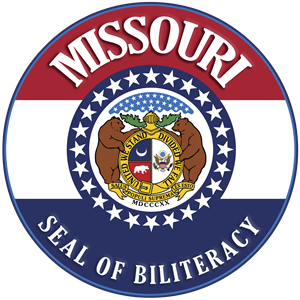OHS offers Seal of Biliteracy testing to multilingual students

Photo courtesy of Liberty Public Schools
With over 7000 languages being actively spoken in the world today, why limit students’ proficiency in just English? OHS now grants an award that recognizes multilingual students who have attained proficiency in two or more languages.
The Seal of Biliteracy is an award that can be granted by the school and honors proficiency in varying languages. In short, high school students who have proved they have proficiency in a language other than English receive a cord and an official Seal on their high school transcript during graduation.
“The Seal of Biliteracy is a wonderful opportunity for students,” department chair of the world languages department Jennifer Straatmann said, “but we have certainly been faced with a number of challenges the past three years. We look forward to promoting this opportunity to a wider range of students in the future.”
The Seal of Biliteracy does not have a limit on the number of languages a student can test for, or the type of language. Only more commonly spoken languages are given the ACTFL Assessment of Performance towards Proficiency in Languages (AAPPL) test. These 13 languages include Chinese (Mandarin), Arabic, English, French, German, Hindi, Italian, Japanese, Korean, Portuguese, Russian, Spanish and Thai.
The AAPPL test consists of four sections: reading, writing, listening and speaking. The test is similar to the National Spanish Exam that many students enrolled in Spanish classes have taken, with the exception of the speaking and writing portion. The American Council on the Teaching of Foreign Languages organization is in charge of grading the test.
While these languages are the most commonly spoken and offered the official testing, other languages that are not recognized as common are offered an alternative to the testing. The students of these languages are given a specific time period to complete what the ACTFL considers a portfolio.
There are two different categories of testing the students can complete based on either their English II EOC score or their ACT English score: they can either earn the Seal of Biliteracy or the Distinguished Seal of Biliteracy. The requirements for both Seals are similar, but they differ in amount of time, length and how well a student has proven they can speak the language. The student making the portfolio is required to submit a summary of an authentic video or audio of the language, a recorded presentation of any academic topic speaking the language, a conversation with a native speaker of the language and a written summary of a current event taken from an credible news article from the home country.
The portfolio is viewed by a native of the home country and is evaluated based on the students’ proficiency of the language. Some portfolio languages that students will be completing this year are Bosnian, Oromo, Vietnamese and Kurdish.
“This year, we have 27 students signed up,” Straatmann said.
Last year, former OHS students Melisa Vilic and Majda Mustajbegovic were the only students who completed the portfolio, and some other students passed the AAPPL test for different languages. Leah Martin, Addie Kettenbrink and Sophie Kettenbrink, all former seniors, received a Seal of Biliteracy with the at-home proctored test for Spanish, and Kaitlyn Gleiforst (12) received the Seal in German.
“This opportunity showed me the value of languages and how important it is to stay consistent to your roots,” Vilic said. “I’m grateful for this opportunity because I know it will benefit me in the future.”
Along with many others, Hailee Schaal (12) is taking the AAPL test for Spanish. The test is available until March 30 and the portfolio is due April 1.
“You can take [the sections on the test] over once,” Schaal said. “If you don’t get it the first time, you can retake certain parts of the test.”

Hi everybody! My name is Leyla Vilic, and I am a senior this year. I love to read all types of books, but especially fantasy, thriller and historical fiction....

